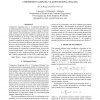Free Online Productivity Tools
i2Speak
i2Symbol
i2OCR
iTex2Img
iWeb2Print
iWeb2Shot
i2Type
iPdf2Split
iPdf2Merge
i2Bopomofo
i2Arabic
i2Style
i2Image
i2PDF
iLatex2Rtf
Sci2ools
ICIP
2006
IEEE
2006
IEEE
Compressive Sampling Vs. Conventional Imaging
Compressive sampling (CS), or “Compressed Sensing,” has recently generated a tremendous amount of excitement in the image processing community. CS involves taking a relatively small number of non-traditional samples in the form of randomized projections that are capable of capturing the most salient information in an image. If the image being sampled is compressible in a certain basis (e.g., wavelet), then under noiseless conditions the image can be much more accurately recovered from random projections than from pixel samples. However, the performance of CS can degrade markedly in the presence of noise. In this paper, we compare CS to conventional imaging by considering a canonical class of piecewise smooth image models. Our conclusion is that CS can be advantageous in noisy imaging problems if the underlying image is highly compressible or if the SNR is sufficiently large.
Related Content
| Added | 11 Jun 2010 |
| Updated | 11 Jun 2010 |
| Type | Conference |
| Year | 2006 |
| Where | ICIP |
| Authors | Jarvis Haupt, Robert Nowak |
Comments (0)

